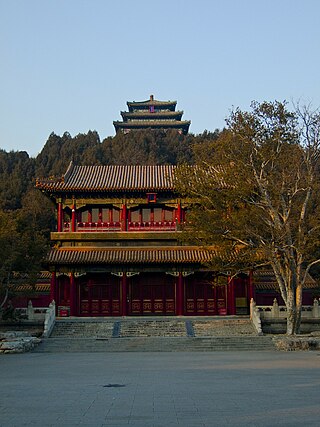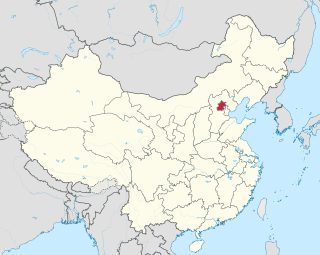
Jingshan Park is an imperial park covering 23 hectares immediately north of the Forbidden City in the Imperial City area of Beijing, China. The focal point is the artificial hill Jingshan. Formerly a private imperial garden attached to the grounds of the Forbidden City, the grounds were opened to the public in 1928. The park was formally established in 1949. It is listed as a Key State Park and is administratively part of Xicheng District in downtown Beijing.

Xicheng is a district of the city of Beijing. Its 32 square kilometers (12 sq mi) cover the western half of the old city, and has 1,106,214 inhabitants. Its postal code is 100032. Xicheng is subdivided into 15 subdistricts of the city proper of Beijing. The former Xuanwu District was merged into Xicheng in July 2010.

Beijing is a municipality located in North China at the northern tip of the North China Plain, near the meeting point of the Xishan and Yanshan mountain ranges. The city itself lies on flat land that opens to the east and south. The municipality's outlying districts and counties extend into the mountains that surround the city from the southwest to the northeast. The highest peaks are over 2,000 m (6,600 ft).

Beihai Park is a public park and former imperial garden immediately northwest of the Forbidden City in Beijing, China.
Many imperial gardens exist in Asia including:

The Imperial City is a section of the city of Beijing in the Ming and Qing dynasties, with the Forbidden City at its center. It refers to the collection of gardens, shrines, and other service areas between the Forbidden City and the Inner City of ancient Beijing. The Imperial City was surrounded by a wall and accessed through seven gates and it includes historical places such as the Forbidden City, Tiananmen, Zhongnanhai, Beihai Park, Zhongshan Park, Jingshan, Imperial Ancestral Temple, and Xiancantan.
Shichahai is a historic scenic area consisting of three lakes in the north of central Beijing. They are located directly northwest of the Forbidden City and north of the Beihai Lake. Shichahai consists of the following three lakes: Qianhai (前海), Xihai (西海) and Houhai (后海). In imperial times it was called the Riverbank.
North Sea or Northern Sea may refer to:
北海, meaning "North Sea" in Chinese and Japanese, may refer to:

A Nine-Dragon Wall or Nine-Dragon Screen is a type of screen wall with reliefs of nine different Chinese dragons. Such walls are typically found in imperial Chinese palaces and gardens.

Beihaibei is a station on Line 6 of the Beijing Subway. This station opened on December 30, 2012. It is named for the nearby Beihai Park.

Taiye Lake or Taiye Pond was an artificial lake in imperial City, Beijing, during the Jin, Yuan, Ming, and Qing dynasties of China. The beauty and utility of the lake was responsible for the siting of Kublai Khan's palace and the position of modern Beijing. It continues to exist but it is now known separately as the North, Central, and South Seas, the three interconnected lakes just west of the Forbidden City in downtown Beijing. The northern lake makes up the public Beihai Park while the southern two are grouped together as Zhongnanhai, the headquarters for the Communist leadership of the People's Republic of China.
White Dagoba or Pagoda may refer to several prominent white stupas in China:

Qingzhou or Qing Province was one of the Nine Provinces of ancient China dating back to c. 2070 BCE that later became one of the thirteen provinces of the Han dynasty. The Nine Provinces were first described in the Tribute of Yu chapter of the classic Book of Documents, with Qingzhou lying to the east of Yuzhou and north of Yangzhou. Qingzhou's primary territory included most of modern Shandong province except the southwest corner.
Beihai Commandery was a historical commandery of China, located in present-day northern Shandong province.
Donglai Commandery was a historical Chinese commandery on the Jiaodong Peninsula, existing from Han dynasty to Tang dynasty.
This page is based on this
Wikipedia article Text is available under the
CC BY-SA 4.0 license; additional terms may apply.
Images, videos and audio are available under their respective licenses.








